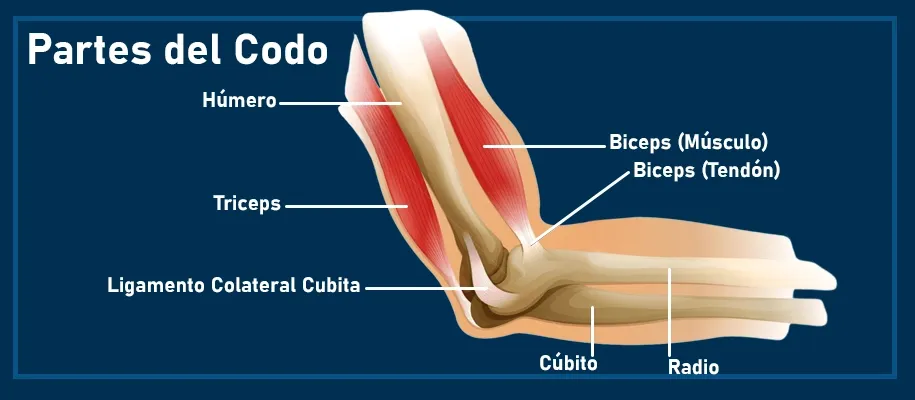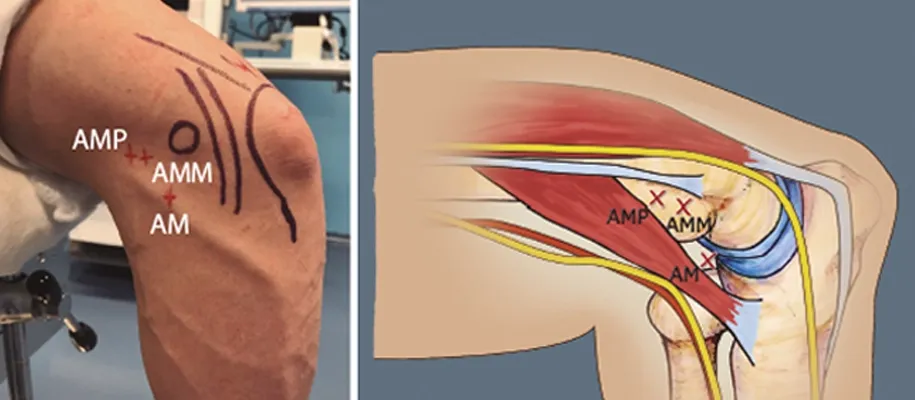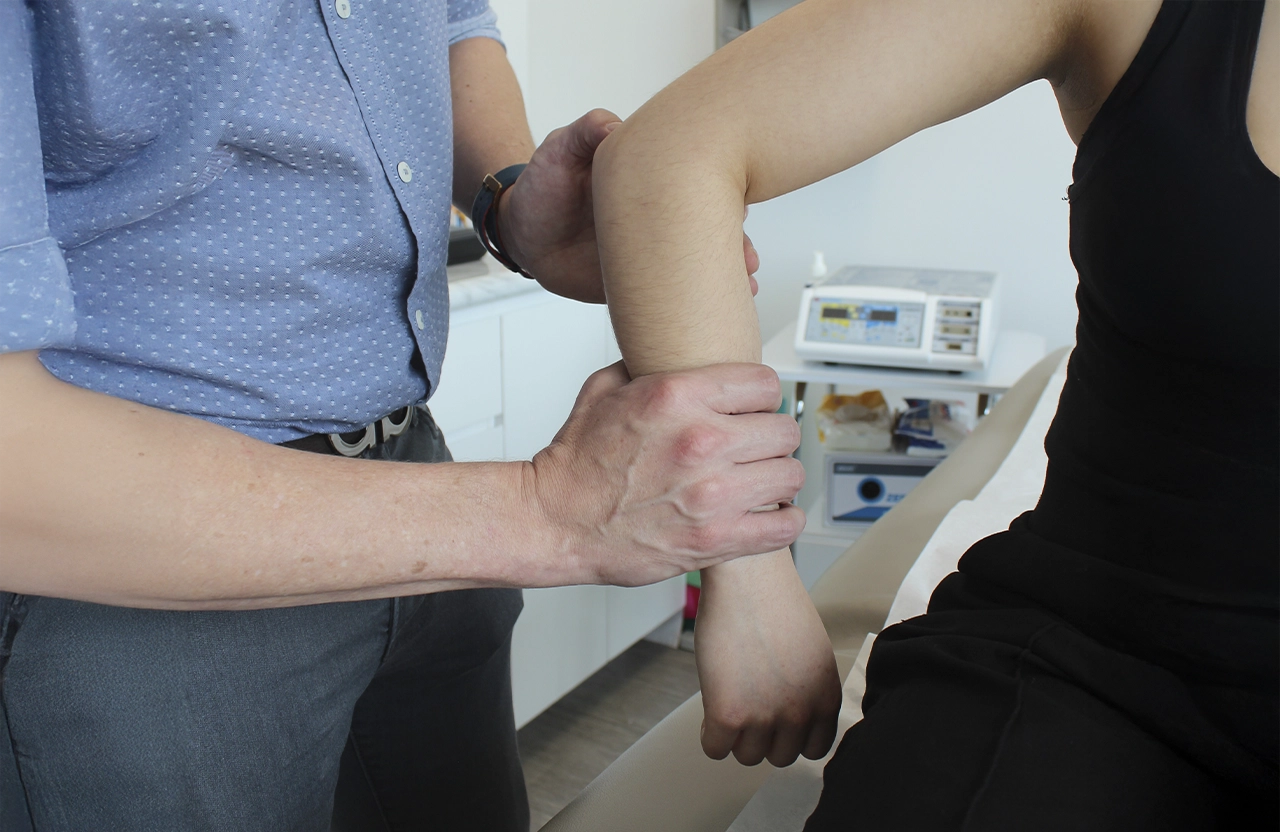Hello, I'm Dr. Ricardo Monge, an orthopedic surgeon specializing in joint injuries in Tijuana, and today I want to talk to you about a procedure that, although practiced for decades, remains one of the most advanced options for treating various elbow conditions:
Arthroscopy
This minimally invasive method allows us to address complex joint problems with much more comfortable recovery for the patient.
Before understanding arthroscopy, it is important to know how this joint is formed.
Elbow Anatomy: Understanding one of the body's most complex joints
Humerus: arm bone.
Radius: forearm bone on the thumb side.
Ulna: forearm bone on the pinky side.
The surfaces of these bones are covered by articular cartilage, a smooth and slippery layer that cushions impacts and allows bones to glide without friction. Additionally, a thin layer of tissue called synovial membrane produces a lubricating fluid that keeps the joint in optimal conditions. The collateral ligaments on the sides provide stability, preventing dislocations.
Inside the elbow we can also find important nerves that control the hand and forearm, making it a delicate area.
Signs your elbow may be giving
Stiffness or loss of arm mobility
Pain when using the elbow for actions like throwing or stretching
Swelling usually accompanied by pain
Visible changes and deformities
Decreased strength in the arm or elbow
Pain when closing the fist
Tingling and numbness in the elbow, hands, wrist and arms

When is elbow arthroscopy recommended?
It is the last option when conservative treatment does not work or the condition is significantly affecting mobility and generating a lot of pain.
It is also recommended to treat:
Tennis elbow (lateral epicondylitis): when the damage caused by small tears and repetitive stress is persistent.
Osteoarthritis and rheumatoid arthritis: Helps improve movement and clean the joint.
Removal of foreign bodies: The most common reason for this type of surgery. Small fragments of cartilage or bone can break off and cause pain or blockage in movement.
Release of scar tissue and bone spurs: Ideal for patients with elbow stiffness, who cannot bend or stretch the arm completely.
Osteochondritis dissecans: A condition that affects young athletes, where a fragment of cartilage separates from the bone.
Arthroscopy: What to expect?
Elbow arthroscopy is an outpatient procedure performed through small incisions.
Preparation: You will be administered anesthesia and the area will be prepared.
Visualization: fluid will be injected into the joint to expand it, giving a clearer workspace. Then, the arthroscope, a very small camera, is inserted through an incision. The images are projected on a screen, allowing us to see inside the elbow in great detail.
Treatment: Through other small incisions, specialized instruments are inserted to perform the necessary treatment, such as scraping, cutting or removing damaged fragments. We can even use special sutures and anchors to repair tissues.
Completion: Once the procedure is completed, the instruments are removed and the incisions are closed with one or two stitches.
Benefits compared to open surgery
Smaller incision size and scars
Lower risk of infection
Less pain and inflammation in the postoperative period
Faster recovery to return to work or sports
Recovery after arthroscopy
Rehabilitation plays an important role so you can resume your daily activities. For this, your physical therapist and I will work together to personalize a treatment plan and exercises to recover movement and strength in the elbow and forearm.
It is important to have support from a family member, friend or caregiver a few days after surgery since your joint requires special care the first few days.
It is normal to experience swelling, discomfort and pain in the operated elbow area. It is important to take the indicated medication and eat properly to facilitate a more optimal recovery for your body. It is also recommended to apply ice with an ice bag. Ice should be applied for periods of 20 to 30 minutes separated by one hour during the first weeks.

What you should and shouldn't do at home after elbow arthroscopy
Recommended actions:
Adequate rest: Quality sleep is essential. It is recommended to sleep in a semi-sitting position, using pillows that provide support and keep the elbow in a stable and safe posture.
Indicated exercises: It is important to punctually comply with the arm and elbow mobility exercises prescribed by the specialist. Additionally, gently moving the fingers helps prevent stiffness and improve circulation.
Light physical activity: Walking gradually promotes blood flow, which contributes to better recovery.
Actions to avoid:
Lifting heavy objects like water jugs, grocery bags or backpacks, as they can compromise the joint.
Performing repetitive movements with the operated arm, as they delay healing and increase the risk of pain or inflammation.
Taking tub baths or submerging the arm, as it increases the risk of infection in the surgical area.
Return to daily activities after elbow arthroscopy
The return to daily activities is usually one of the main concerns after surgery. However, it is essential not to rush recovery or compare it with that of other people, since each organism responds differently. The time and rehabilitation plan will depend on the type of approach performed and should always be evaluated together with your physical therapist.
The body is wise and has its own healing rhythm and it is necessary to listen to it and give it that push it requires to reintegrate into normality, be patient. Little by little, it's about respecting recovery times. Only then will you be able to enjoy a version of yourself without pain or discomfort, achieving a full and safe recovery.
Reincorporation to sport
In the case of high-performance athletes, the return to sports activity must be gradual and carefully supervised. Some recommendations include:
Perform a prolonged warm-up before each session.
Pay attention to technique in all movements to avoid overloading the joint.
Do not exceed the time or intensity of training in the initial phases.
Gradually increase the workload, as recovery allows.
Following these indications is key to preventing relapses and achieving a safe and successful return.
If you want to know more about elbow arthroscopy or are looking for a second opinion for your pain—whether you are a high-performance athlete or facing a limitation that has not improved with conservative treatment—I invite you to a consultation.
I am located in Tijuana, at Torre Norte 2, a few minutes from the border line, and we accept various medical insurances.
As a specialist in joint injuries, it will be a pleasure to support you in your recovery process so you can regain your mobility, well-being and independence.
Trust your traumatologist in Tijuana for the management of your elbow pain. I am here to help you.
No hay comentarios para este blog.
